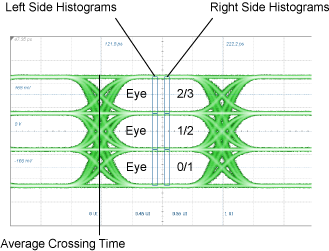PAM Partial Noise Margin
 The Partial Noise Margin measurement measures the electrical output of an O/E receiver. The measurement actually performs three individual noise-margin measurements where each measurement is based on the contribution of a single PAM4 eye. So, noise margin is reported for Eye 0, for Eye 1, and for Eye 2. This differs from the standard Noise Margin measurement where a single measurement includes the contribution of all three eyes. By comparing the individual noise-margin contribution of each eye, you can gain additional insights into the causes of any measurement problems.
The Partial Noise Margin measurement measures the electrical output of an O/E receiver. The measurement actually performs three individual noise-margin measurements where each measurement is based on the contribution of a single PAM4 eye. So, noise margin is reported for Eye 0, for Eye 1, and for Eye 2. This differs from the standard Noise Margin measurement where a single measurement includes the contribution of all three eyes. By comparing the individual noise-margin contribution of each eye, you can gain additional insights into the causes of any measurement problems.
When the measurement is started, you're prompted to select one of two vertical histograms on which to perform the measurement: left or right side of the selected eye. The location of these histograms is annotated on the displayed waveform. Like the TDECQ measurement, these two vertical histograms are located at 0.45 UI and 0.55 UI from the waveform's average crossing time as is shown in the following figure. Unlike the display for the Noise Margin measurement, red pixels areas are not highlighted on the waveform.

Noise margin is a system-level test that measures the amount of noise power that can be added to a system while maintaining its performance at a specific Symbol Error Ratio (SER) at the output of an O/E receiver. This differs from a TDECQ measurement which is performed at a transmitter's output and is not a system-level test. TDECQ is unsuitable for a system-level test due to the expectation that TDECQ remains constant if overall optical power and OMA is reduced in a linear method.